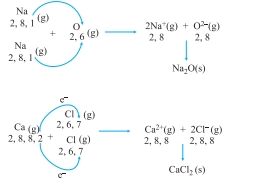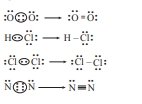NIOS Class 10 Science and Technology Chapter 7 Chemical Bonding Solutions to each chapter is provided in the list so that you can easily browse through different chapters NIOS Class 10 Science and Technology Chapter 7 Chemical Bonding and select need one. NIOS Class 10 Science and Technology Chapter 7 Chemical Bonding Question Answers Download PDF. NIOS Study Material of Class 10 Science and Technology Notes Paper 212.
NIOS Class 10 Science and Technology Chapter 7 Chemical Bonding
Also, you can read the NIOS book online in these sections Solutions by Expert Teachers as per National Institute of Open Schooling (NIOS) Book guidelines. These solutions are part of NIOS All Subject Solutions. Here we have given NIOS Class 10 Science and Technology Chapter 7 Chemical Bonding, NIOS Secondary Course Science and Technology Solutions for All Chapters, You can practice these here.
Chemical Bonding
Chapter: 7
INTEXT QUESTIONS 7.1
1. State octet rule.
Ans: The octet rule states that an atom tends to have eight electrons in its outermost valence shell by forming covalent bonds through gaining or losing electrons from its outermost shell.
2. Why noble gases are non-reactive?
Ans: Because they have inert gas configuration which makes it very stable.
3. In the table given below three elements and their atomic numbers are given. Which of them are stable and will not form compound?
Ans: A and B.
INTEXT QUESTIONS 7.2
1. Name the two types of ions present in NaCl.
Ans: Sodium ion Na+ and chloride ion Cl–.
2. How many shells are present in Na+ ion?
Ans: Two (2).
3. What is the number of electrons present in Cl– ion?
Ans: 18.
4. Name the type of force of attraction present in ionic compounds.
Ans: Electrostatic force of attraction.
5. In sodium chloride lattice, how many Cl– ions surround each Na+ ion?
Ans: Electrostatic force of attraction.
6. Show the formation of Na2O, CaCl2 and MgO.
Ans:


7. Why NaCl is bad conductor of electricity in solid state?
Ans: Due to absence of free Na+ and Cl– ion.
INTEXT QUESTIONS 7.3
1. How covalent bonds are formed?
Ans: A covalent bond is formed by sharing of equal no. of electrons between two atoms.
2. Show the formation of O2, HCl, Cl2 and N2.
Ans:

3. How many covalent bond(s) is/are present in following compounds:
(i) H2O.
Ans: 2.
(ii) HCl.
Ans: 1.
(iii) O2.
Ans: 2.
(iv) N2
Ans: 3.
4. State loss or gain of electrons (giving their number) in the following changes:
(i) N ⎯→ N3–.
Ans: Gain of 3e–..
(ii) Cl ⎯→ Cl– .
Ans: Gain of 1e–.
(iii) Cu ⎯→ Cu2+.
Ans: Loss of 2e–.
(iv) Cr ⎯→ Cr3+.
Ans: Loss of 3e–.
5. Why is ethyl alcohol is bad conductor of electricity in its aqueous solutions?
Ans: Ethyl alcohol do not produce H+ ion in its aqueous , hence does not conduct electricity.
| TERMINAL EXERCISE |
1. Why ionic compounds conduct electricity in aqueous solution?
Ans: There is free electrons in ionic compounds which helps in transferring the electricity between one place to another. As the cation and anion present in ionic compound helps for the conducting of electricity.
2. Covalent compounds have low melting point than an ionic compound why?
Ans: As we all know the covalent bonds are loosely connected by their bond which has low melting point and boiling point. But in ionic compounds the bond is strongly connected by the element’s melting point is high.
3. Explain the formation of Na+ ion from Na atom.
Ans: The electronic configuration of Na is (2,8,1) and this one electron is losing to form Na (+) and then make the compound.
4. How would you explain the bonding in MgCl2?
Ans: In magnesium there are 2 free electrons in their last shell and in chlorine there is needed one electron to form the compound so the electron is accepted by chlorine elements to form the compound MgCl2.
5. Which of the following statements are correct for ionic compounds:
(i) They are insoluble in water.
(ii) They are neutral in nature.
(iii) They have high melting points.
Ans: (iii) They have high melting points.
6. State three characteristic properties of ionic compounds.
Ans: Three characteristic properties of ionic compounds.
(i) They are strongly connected by ionic bonds.
(ii) They have a high melting point.
(iii) They have a low melting point.
7. How does a covalent bond form?
Ans: A covalent bond consists of the simultaneous attraction of two nuclei for one or more pairs of electrons. The electrons located between the two nuclei are bonding electrons.
8. What is the number of solvent bonds present in the following molecules?
(i) Cl2.
Ans: Cl2: 1 solvent bond (between the two Cl atoms).
(ii) N2.
Ans: N2: 1 solvent bond (between the two N atoms).
(iii) O2.
Ans: O2: 1 solvent bond (between the two O atoms).
(iv) H2 .
Ans: H2: 1 solvent bond (between the two H atoms).
9. Classify the following statements as true or false:
(i) Ionic compounds contain ions which are held together by weak electrostatic forces.
Ans: False.
(ii) Ionic compounds have high melting and boiling points.
Ans: True.
(iii) Covalent compounds are good conductors of electricity.
Ans: False.
(iv) Solid sodium chloride is a good conductor of electricity.
Ans: False.
10. Classify the following compounds as ionic or covalent:
(i) Sodium chloride.
Ans: Ionic bond.
(ii) calcium chloride.
Ans: Covalent bond.
(iii) Oxygen.
Ans: Covalent bond.
(iv) Hydrogen chloride.
Ans: Covalent bond.
(v) Magnesium oxide.
Ans: Covalent bond.
(vi) Nitrogen.
Ans: Covalent bond.
11. An element ‘X’ has atomic no. 11 and ‘Y’ has atomic no. 8. What type of bond they will form? Write the formula of the compound formed by reacting X.
Ans: So X is Na or sodium and Y is oxygen or O2. These two elements form the compound N2O by sharing electron or named as covalent bond.
12. Name the type of bonds present in H2O molecules.
Ans:Strong linkages—called covalent bonds—hold together the hydrogen (white) and oxygen (red) atoms of individual H2O molecules. Covalent bonds occur when two atoms—in this case oxygen and hydrogen—share electrons with each other.

Hi! my Name is Parimal Roy. I have completed my Bachelor’s degree in Philosophy (B.A.) from Silapathar General College. Currently, I am working as an HR Manager at Dev Library. It is a website that provides study materials for students from Class 3 to 12, including SCERT and NCERT notes. It also offers resources for BA, B.Com, B.Sc, and Computer Science, along with postgraduate notes. Besides study materials, the website has novels, eBooks, health and finance articles, biographies, quotes, and more.


